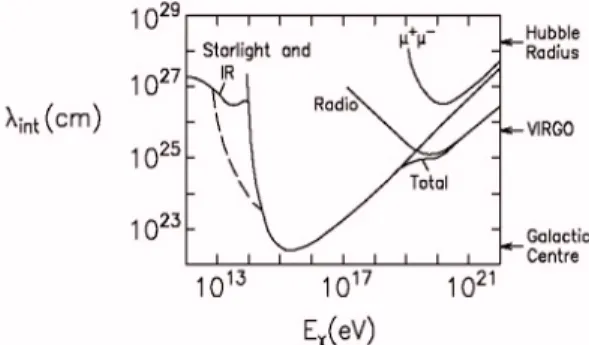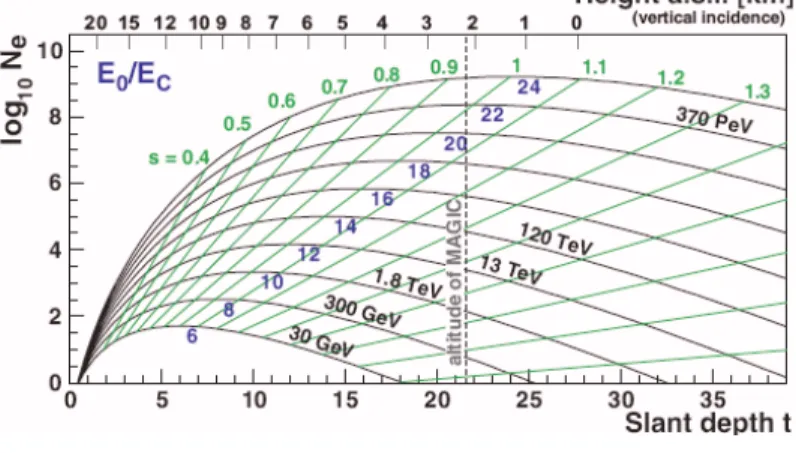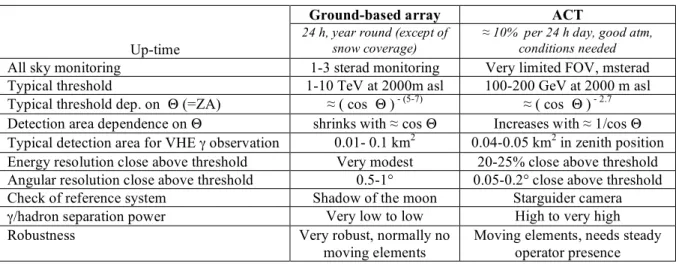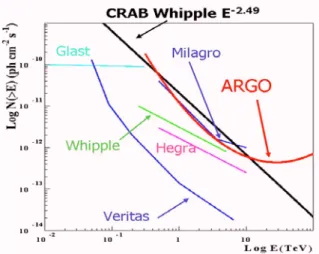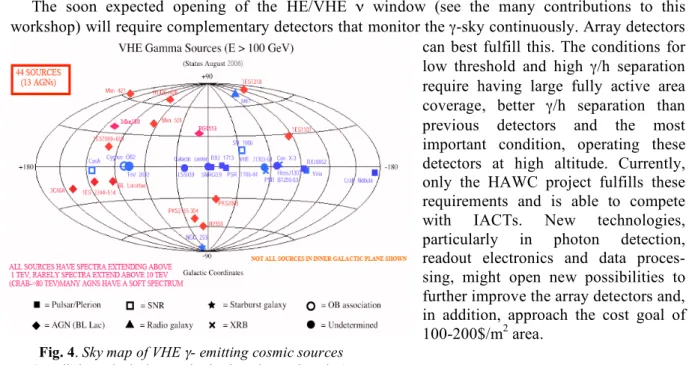Gamma-ray astronomy with ground-based array detectors: status and perspectives
E. Lorenz
Max Planck Institute for Physics, Foehringer Ring 6, D80805 Munich, Germany e.lorenz@mac.com
Abstract. The basic concept and the status of currently operating ground-based array detectors for VHE gamma-ray astronomy will be presented and compared with imaging air Cherenkov telescopes. Also an outlook of future prospects will be given.
1. Introduction
The window of very high energy (VHE) gamma-ray (shortcut!) astronomy has been opened by the detection of TeV !s from the Crab nebula [1] in 1989. Since then this field of research is steadily expanding and many more sources have been discovered and important physics information about the ultra-relativistic universe have been obtained. Although!s are only a very small fraction of the cosmic ray (CR) flux steadily bombarding the earth, they are the currently best suited ‘messengers’ of ultra- relativistic processes in our universe. Charged CRs are not suitable because they are deflected by the weak galactic magnetic fields and cannot be correlated with specific cosmic sites (stars, galaxies….).
The only exceptions might be CRs above 1019eV. Only neutral particles –!s, vs, neutrons and may be dark matter particles–are suited as cosmic messengers to be correlated with specific sites. Dark matter particles still await their discovery and energetic neutrons might allow one at most to explore the very close-by universe because of their short life-time. Neutrinos are in principle also promising messengers because they are, as weakly interacting particles, not absorbed in the universe, but their small interaction cross-section makes detection extremely difficult and require huge detector volumes.
It is hoped that the current efforts to build such detectors will eventually lead to the detection of the first source emitting high energy neutrinos (Up to now only two cosmic HE neutrino emitters have been detected, the Sun and SN 1987A). Gamma-rays have specific features making them particularly suitable to act as messengers:
• They have infinite lifetime
• They fly on straight lines from the point of generation to the earth, i.e. VHE !s can easily extrapolated back to the sources.
• As massless particles they fly with the speed of light and can transmit correct timing information from process at the origin.
• Gamma rays are not accelerated in classical ways like charged particles and thus require higher energy ‘parent’ processes for generation.
The possible production processes of VHE!s are:
IOP Publishing Journal of Physics: Conference Series 60 (2007) 1–7
doi:10.1088/1742-6596/60/1/001 Proceedings of the TeV Particle Astrophysics II Workshop
1
© 2007 IOP Publishing Ltd
• Hadronic processes such as for example a high energy proton (expected to be accelerated by shock waves) interacting with some matter (normally close to or part of some stellar object) leading to dominantly pion production as
Phigh energ() Nrestgas -/ p1 ) N1)22"))"-)"322 456
with the charged pions decaying into muons (-> e +#) and#s and the"0into!!. Reaction (1) stands for a number of hadronic interaction channels with decay channels leading both to VHE # and ! production. The simultaneous discovery of both, ! and #, would be proof of acceleration of hadrons, which in case of galactic origin, could eventually also show up as the charged CRs detected on earth.
• Leptonic production of high energy electrons upscattering low energy photons via inverse Compton scattering
ehigh energ( ) photonlow energ(-/ elow energ()!high energ( 4:6
;ufficient target photons can be found close to stellar obAect 4thermall( generated photons6 or generated b( s(nchrotron radiation from the accelerated photons or even from the cosmic microwave background 4EMGB6.
• Possible other production processes can be the deca( and subseJuent hadronisation of superheav( particles K Lopological defects or Melic particles from the earl( universe- or from interactions of ultrahigh protons with the EMGB.
Lhe observation range of long distance cosmic !s above a few tens of NeV is limited b( their possible interaction with various low energ( cosmic photon fields 4EBL6 such as the EMGBR visible and infrared starlightR cosmic radio background etc.
!high energ( ) photonlow energ( -/ e)) e- 4S6
with the cross section peaking close above threshold of e)e- production. Fig 5. shows an earl(
calculation of the absorption length as a function of the ! energ(. Meaction 4S6 is of importance for ground-based ! detection. Uround 535V eV the observation range is limited to the ver( close b(
universe and onl( v astronom( would be viable for the observation of distant processes. ;omewhere below 5355 eV K the eWact value is unknown because of the unknown IM background- the universe becomes highl(
transparent and one could in principle detect sources up to high redshifts. Lo reach such a low threshold is an important challenge for all detectors for VHE
!astronom(.
Fig. 1 Attenuation length of cosmic!s in the universe as a function of energy
2. The general array detector concept
Lhe earth atmosphere is an effective shield against cosmic radiation and thus prevents direct observation of!s from ground. In the ZeV[MeV energ( domain the best detectors for!-astronom( are satellite borne ones with an anticoincidence shield against the dominant charged EMs. Ut VHE the! fluW is much lower and ground-based detectors using indirect detection methods with collection areas eWceeding that of satellite borne ones b( man( orders of magnitude have to be used. Ull current high-
energ( detectors follow the calorimetric principle. Lhe atmosphere acts as an absorber 4air mass 5: :]
radiation length 4rl6R 55 hadronic absorption length6 and some secondar( Juantit( 4shower tail particlesR Eherenkov lightR Fluorescence lightR possibl( Madio waves6 related to the incident direction and energ( can be measured with a suitable detector. High energ( particles interact with nuclei of the top la(er of the atmosphere and loose their energ( b( a multiple reaction chain resulting in eWtended air showersR in case of!s electromagnetic 4em6 showers with ver( few hadronic particles and muons
while hadronic particles produce so- called hadronic showersR which nevertheless are dominated b( the em sub-showers at the tail with a significant admiWture of muons and #s. Us #s escape undetectedR onl( a fraction of the incident energ( is dumped into the atmosphere. ^ne of the main challenges of ground-based detectors is the selection of!-candidates from the man(
orders more freJuent hadronic cosmic particles.
Fig. 2.Monte Carlo simulation of secondary electron multi- plicity in an em shower in the atmosphere as a function of the slant depth (in units of rl), parameter initial! energy.
Lhe VHE detectors follow two main principles: a6 detection of Eherenkov lightR dominantl( produced b( the ultra-relativistic particles in the shower maWimum and b6 the detection of shower tail particles reaching ground. Madio or air fluorescence detection is still unsuited because of the ver( low signal intensit( from VHE showers. Lhe Eherenkov light is normall( detected b( so- called imaging air Eherenkov telescopes 4IUEL6 with a ver( small field of view 4F^V6 allowing up to now observations of onl( discrete source locations 4with one eWception6. Lhe incident direction and energ( is derived from the anal(sis of the shower image_ for details of the conceptR see for eWample overview article ref `:a.
U single telescopeR or if affordableR several ones are sufficient to observe sources. ;hower tail detectorsR here called ground-based arra( detectorsR are normall( sensitive to the charged shower tail particles. Normall( the direction of the incident particle is determined b( time of flight measurements of the scattered tail particle and the energ( b( the densit( of the tail particles. Lhe main advantages of arra( detectors are that the( allow monitoring a large section of the sk( and that the( are sensitive for :b h a da(. Lheir main disadvantages are the high threshold because of the reJuirements that sufficient tail particles have to reach groundR the poor angular and energ( resolution close above threshold and also the modest![hadron separation power. Lable 5 compares the essential parameters of state of the art VHE arra( detectors and IUELs. Lhe basic sensors for arra(s are nowada(s either scintillation counters 4plastic or liJuid scintillators6 or encapsulated water Eherenkov detectors in form of water tanks or large ponds subdivided into light-tight sections. In all cases the scintillation light or Eherenkov light is detected b( high sensitive photomultipliers 4PML6. Lhe high costsR particularl( for scintillation countersR normall( limit the areaR respectivel( the active area coverageR leaving often onl( the choice of either a large detector with ver( modest active detector coverage resulting in a ver( high threshold or in a small area with a high active detector coverage and a lower threshold. From current resultsR mainl( from observations with IUELsR we know that a low thresholdR well below the 535S-5beV threshold of past arra( detectors is absolutel( essential for the future use of arra( detectors.
Figure : shows a ME simulation of secondar( electrons along the shower depth 4in units of rl6 as a function of primar( ! energ(. csing the somewhat arbitrar( reJuirement of detecting at least 533 particles to trigger and retrieve useful information about the incident!one can deduce the threshold in zenith for an arra( detector for a given altitude and active area fraction as well as the zenith angle
dependence from the overburden of air mass as function of$. Lhe threshold of arra( detectors rises with a ver( steep function of the zenith angleR!4cos$6-4V-]6. Due to shower fluctuations a threshold of 533 particles does not correspond to a fiWed energ(. For defining the threshold one commonl( uses in the!-astronom( communit( the peak of the observed differential spectrum.
Ut the shower tail there are about seven times more low energ( secondar(!s than electrons. LhusR b( using appropriate convertersR which do not absorb too man( electrons one can somewhat lower the threshold.
Table 1: Comparison of main parameters of a typical array detector and an air Cherenkov telescope
Ground-based array ACT
Up-time
24 h, year round (except of snow coverage)
!10% per 24 h day, good atm, conditions needed All sky monitoring 1-3 sterad monitoring Very limited FOV, msterad Typical threshold 1-10 TeV at 2000m asl 100-200 GeV at 2000 m asl Typical threshold dep. on $(=ZA) !( cos $)- (5-7) !( cos $)- 2.7 Detection area dependence on$ shrinks with!cos$ Increases with!1/cos$ Typical detection area for VHE!observation 0.01- 0.1 km2 0.04-0.05 km2in zenith position Energy resolution close above threshold Very modest 20-25% close above threshold Angular resolution close above threshold 0.5-1° 0.05-0.2° close above threshold
Check of reference system Shadow of the moon Starguider camera
!/hadron separation power Very low to low High to very high
Robustness Very robust, normally no
moving elements
Moving elements, needs steady operator presence
3. Current experiments and some selected results
Until 10-15 years ago array detectors were the main ‘workhorse’ for the search of !-emitting sources, which were assumed to be also sources of CRs. The basic detector comprised an array of scintillation counters of rather coarse sampling of <0.5% to about 2% active area coverage. All of these experiments failed to detect !-sources. Reasons were a much too high threshold (can be immediately deduced from fig. 2 when requiring a minimum of about 100 secondary particles hitting the active material) and a much too poor!/hadron separation. Other effects contributing to the failures were operation at low altitude (large overburden), very modest angular resolution and energy resolution close to the threshold. Extragalactic sources were anyhow impossible to detect because of the absorption of VHE !s due to the interaction with the EBL. Gradually, experiments moved to higher altitude and increased the active detector fraction eventually to practically 100%. Currently only three large array detectors with a sufficiently low threshold to detect the strongest galactic and low redshift sources are operating worldwide: the Tibet AS III array [3], the Argo YJB array [4] at the same site and the MILAGRO detector [5]. Table 2 lists some of the essential parameters and Figure 3 shows the sensitivity as a function of energy in comparison with some other detectors.
Table 2: Comparison of the threshold and sensitivity of current large array detectors
Height Coordinates Area Threshold Sensitivity/year
Tibet AS III 4300 m asl 90.5° E, 30.1° N 270x270 m2, 150x150m2 higher density infill
!3 TeV !1 Crab
ARGO YBJ 4300 m asl 90.5° E, 30.1° N 10000m2after completion 0.5-1 TeV !0.3 Crab
Milagro 2630 m asl 60 x 80 m2 !2 TeV !0.5 Crab
Figure 3.Sensitivity of some!-ray detectors.
Lhe Libet U; arra( resembles most closel(
the classical scintillator arra( detector and has been modified during the past (ears. ^riginall( it was an arra( of rather coarse grid of scintillation counters with a ver( low active detector fraction.
;uccessivel( the arra( was modified b( reducing the spacing between counters and increasing their numbers as well as the overall size. Lhe first discover(R besides the shadowing of EMs of the moon and sun 4a ver( important measurement for the orientation of the arra(6 was the observation of the EMUB nebula with V.V % over an observation time of VV3 da(s. UlsoR evidence for the ! emission from Mkn V35 during a high state in 5ff] was reported `ga. Lhe real strength of the instrument is the all-sk(
surve( potential. Besides the observation of the Erab nebula a number of so-called hot spotsR local clusters of particles above the continuum background of charged EMsR e.g.R potential signals above b but below V%have been detected `]a.
Lhe Urgo detectorR located at the same site as the Libet U; detectorR follows the line of a high altitude arra( with basicall( 533 h active area coverage b( means of resistive plate chambers 4MPE6 that allow to measure the transit times of individual particles with ver( high 4i 5 nsec6 precision. Lhe arra( is complemented b( a la(er of leadR acting as a converter for the more freJuent low energ(
secondar(!sR and a second la(er of MPEs. Lhe detector is shortl( before completion. Initial tests with a smaller section and shorter observation times of the arra( have not (et resulted in a positive identification of sources `ja.
Lhe Milagro detector is currentl( the most advanced full( active arra( detector based on a largeR rather deep water pond eJuipped with a rather dense grid of PMLs detecting the Eherenkov light of shower tail particles. Lhe depth of the pond is deep enough to convert also most of the shower tail!s without stopping the low energ( electrons before their detection 4a problem with scintillation counters with lead converters6. ^ne of the problems of Milagro was its relativel( small eWtensionR e.g. most showers were onl( partiall( hitting the sensitive areaR leading thus often to ambiguous identification.
Lhis has been improved b( adding outside water pond detectors. U remarkable progress in ![hadron identificationR a notorious problem in tail catcher calorimetersR has been achieved b( a new anal(sis method based on the particle hit pattern in the pond 4see contribution to this conference6. During this conference a number of new results have been reportedR demonstrating the superior power of a full(
active detector 4see contribution B. UllenR k. Noodman and N. lodh to this conference6 compared to the classical scintillator arra( detectors.
I would like to briefl( mention that besides the arra( reaching at least partiall( to below a LeV there eWist also arra(s with much higher thresholds and a different ph(sics goalR e.g. to stud( ph(sics linked to the charged EMs. Lhe Zaskade `fa and its follow-up eWtension Zaskade Nrande at Zarlsruhe is basicall( a classicalR coarsel( sampled scintillator arra( complemented b( muon detectors and a large central hadron calorimeter. Lhe arra( has a threshold of ! 533 LeVR i.e.R above all up to now identified sources. U source search `53a gave no positive results. Ulso the search for diffuse !s from the galactic plane was negative.
U completel( different concept of an arra( detector is followed b( the Lunka collaboration. Lunka
`55a and its follow up proposal Lunka 5:V consists of an arra( of large open PMLs observing during dark clear nights Eherenkov light emitted b( large showers in the sk( Lhe detector has a superior angular resolution and a ver( good energ( resolution compared even to IUELs due to multiple
sampling of the large diameter Eherenkov light disk. Lunka aims primar( for the stud( of EMs around the knee but the principle allows lowering the threshold close to 5 LeV. Lhe third oneR the IceLop
`5:a detector on the ;outh Pole is again a classicalR coarsel( sampled arra( detector following the ice Eherenkov tank concept. Lhe Eherenkov radiators are made from frozenR carefull( purified water.
IceLop serves mainl( for the calibration of IceEube.
In summary, one can conclude that current array detectors of a low threshold just barely see the strongest VHE!–emitting sources with ! 5 %/year such as Crab and Mkn 421, 501 and in case of Milagro an extended hotspot around the Cygnus region (see contribution to this conference). The array detectors with higher thresholds see no source signals. This is in stark contrast to results of current IACTs, despite the array’s much longer up-time and all sky monitoring ability. The high threshold and the large increase of it as a function of the zenith angle anyhow restrict observations to galactic sources and very low redshift AGNs and GRBs. A look at the future shows that some modified concept or change of detectors could make the array detectors again competitive for special searches.
4. Improvements of current arrays and next generation detectors
The current progress of the Milagro detector show the directions for the future. Classical array detectors have a rather modest !/h separation. The new analysis technique of Milagro nevertheless shows that progress can be made by analyzing the hit pattern in a fully active detector leading in this case to an improved quality factor (Q-factor) for !/h separation of up to 8, which brings Milagro closer in performance to IACTs. Another must for tailcatcher calorimeters for lowering the threshold is installing them at high altitudes as can be directly concluded from fig. 1. Shower tail particles are spread over a large area. As a consequence many old arrays often were too small to contain the entire shower tail area and thus led to mistakes in energy and angle determination. The only currently proposed new array detector which incorporates better!/h separation, lower threshold, in part by the conversion of the numerous tail!s, and a fully active area sufficiently large to contain the full pattern of showers close above threshold is the HAWC project [13], based on the Milagro concept. Besides a larger area and a high site altitude also better technology should improve the pond detectors. For example the use of Tyvek or Teflon foil or dielectric mirror foil VM2000 from 3M should result in better light collection. Water-soluble wavelength shifters [14] can randomize the Cherenkov light and shift a significant part of the UV light to the peak sensitivity of PMTs. Also progress in PMTs is possible to both lower the cost and increase the sensitivity such as so-called Smart PMTs [15], [16]
concept. New readout electronics such as low cost, low power GHz F-ADCs based on large switched capacitor arrays will allow to record the signal development with high time resolution and further allow to improve angular resolution and!/h separation as well as acting in part as delay lines.
For the time being the MILAGRO/Hawc concept at high altitude seems to be the only viable concept for tailcatcher calorimeters with a sufficiently low threshold and good!/h separation. If one is willing to accept to give up the 24 h up-time one can build wide angle Cherenkov detectors, such as an improved version of the AIROBICC/TUNKA array of large open PMTs looking directly into the sky (threshold restricted to above 1 TeV) or arrays of medium size IACTs which cover a large section of the sky by pointing each to another small area. These telescope arrays CTA [17], HE-ASTRO [18]
are still in the early design phase but promise a low threshold and high!/h separation, albeit without 24 h up-time.
5. Conclusions
Most of the current discoveries in VHE!astronomy (see some of the contributions and the review summary to this workshop by F. Krennrich) have been achieved by IACTs because of their superior
!/h separation and lower thresholds. The situation is highlighted by the skymap of!-sources, figure 4, nearly all of which were discovered in the last 15 years by IACTs. Nevertheless there exists a physics area which cannot be exploited by IACTs and where new high sensitivity, low threshold array detectors can make important contribution to the field:
• Observation of rarely flaring AGNs, which might happen during day-time
• Search for cosmic sources in which dominantly hadronic production of!s occur and where X- ray satellites are unlikely to give guidance to IACTs
• Observation of large structures (extended sources….)
• Detection of short (<few sec) GRBs. The detection of these sources is, except by accident, excluded for IACTs because of too slow response.
The soon expected opening of the HE/VHE # window (see the many contributions to this workshop) will require complementary detectors that monitor the!-sky continuously. Array detectors can best fulfill this. The conditions for low threshold and high !/h separation require having large fully active area coverage, better !/h separation than previous detectors and the most important condition, operating these detectors at high altitude. Currently, only the HAWC project fulfills these requirements and is able to compete with IACTs. New technologies, particularly in photon detection, readout electronics and data proces- sing, might open new possibilities to further improve the array detectors and, in addition, approach the cost goal of 100-200$/m2area.
Fig. 4.Sky map of VHE!- emitting cosmic sources (not all shown in the inner galactic plane due to cluttering)
Acknowledgements
I would like to thank my many colleagues from other experiments, who helped me with important details. Also I would like to thank Sybille Rodriguez for helping me to prepare the manuscript.
References
`5a L. E. Geekes et al.R Ustroph(s. k. 45fjf6 Sb:
`:a L. E. Geekes: Lhe atmospheric Eherenkov techniJue in Ver( High Energ( Namma-Ma( Ustronom(.
;pace ;cience Meviews. ;pringer Netherlands, Vol. 75, Nr 1-2 (1996)
`Sa M.Umenomori et al.R astro-ph[3g553S3 v 5
`ba E. Bacci et al.RAstron. Astrophys. Suppl. Ser.138, 597{598 (1999)
`Va M. Utkins et al. Nuc. Inst. Meth. U449R b]j 4:3336
`ga M.Umenomori et al.R astro-ph[333:S5b
`]a ;.G. EuiR E.L. lan: U wide sk( surve( for LeV g-ra( sources b( using the Libet III air shower arra(.
^N :.:. Procs. :jthIEMER Lok(oR :S5V 4:33S6
`ja ;. Vernetto et al.R ;k( surve( with the UMN^-lkB detectorR Procs :fthIEMER PuneR 535 4:33V6
`fa L. Untoni el al.R Nuc. Inst. Meth. U315R bf3 4:33S
`53a L. Untoni et al.R Ustroph(s. k.608. jgV 4:33b6
`55a D. V. Ehernov et al.R Proc. :]th IEMER HamburgR v.:R Vj5 4:3356
`5:a L. Z. NaisserR Procs. :jthIEME Lok(oR 555] 4:33S6
`5Sa N. ;innis et al.R astro-ph[3b3S3fg
`5ba k.Nebauer et al._ Nuc. Inst Methods. U5184:33b6R 5fj
`5Va E. LorenzR D Ferenc: U new Meadout of large area ;mart Photomultipliers b( Neiger-mode UPDs. Proc.
53th. Pisa Meeting on Udvanced Detectors. Nuc. Inst Methods in print
`5ga U.Braem et al.: Lhe m-HPD-Eonceptual ;tud( of a large ;pherical H(brid Photomultiplier. EEMN-PH- EP[:33g-3:V
`5]a G. Hofmann MPI Heidelberg. ELU Eherenkov telescope arra(R presentation to E;FMI. http:[[www.mpi- hd.mpg.de[hfm[ELU[test[ELUnE;FMInprop.pdf
[18] V. Vassiliev and ;. FeganR astro-ph[3V55Sb:
